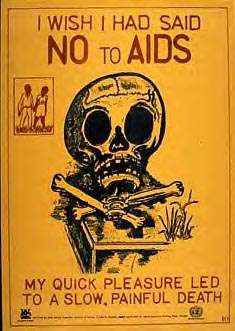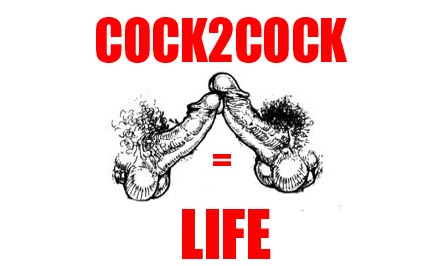




Condom promotion in Uganda not reducing HIV risk, study shows






Condom promotion in Uganda not reducing HIV risk, study shows

Condom promotion in Uganda not reducing HIV risk, study shows
9-15-2005
This is an article which appeared in AIDSMap.
The article was sent to me by a congressional staffer with whom I've
been in correspondence for several years, and I've reproduced here his
characteristic use of red type and underlining.
Although the study involved heterosexual men in Uganda, it has
implications for the prevention of HIV among gay and bi "men who have sex with men" in America.
I discuss those implications in my return letter to the staffer, which I've posted at the end of the article.
Bill
Condom promotion in Uganda not reducing HIV risk, study
shows
Keith Alcorn, Tuesday, September 13, 2005
A study of condom distribution and promotion in
Uganda has found that whilst education in condom use increased uptake,
it did not lead to consistent use in the following six months. Men in
the intervention group went on to have a larger number of sexual partners and were somewhat less likely to use condoms with casual sex partners than the control group. The findings are published in the September 1st edition of the Journal of Acquired Immune Deficiency
Syndromes.
The findings are unlikely to be welcomed by those who argue that the
Ugandan government is deliberately turning its back on condom promotion
in order to please US funders and evangelical Christians, and raise
uncomfortable questions about the evidence base that informs the current international orthodoxy in HIV prevention.
The study compared two groups recruited from poor urban communites in Kampala. It was designed to overcome barriers to condom access and a
lack of skills in condom use identified in Uganda. The authors note that improved availability of condoms in Uganda has had only a modest effect on condom uptake.
One group of men (n=213) was invited to attend a workshop on condom use which explained the aims of the study, demonstrated how to use condoms, discussed how to negotiate condom use and gave participants general information about HIV in Uganda. Participants were also given vouchers that could be redeemed for condoms at local outlets, and the vouchers were used to monitor the uptake of condoms in the intervention group.
The control group was invited to attend to a workshop which gave
general information about HIV in Uganda and provided vouchers for condoms.
All participants were asked about their sex partners and condom use at baseline and after six months. Seventy-seven per cent of the
intervention group actually attended a workshop.
Members of the intervention group were more likely to be married and a larger proportion were aged 25 to 30 years (although this difference
was not significant).
Men in the intervention group redeemed significantly more condom
vouchers during the follow-up period (mean 110 vs 13 in the control group, p=0.002). However, whilst the proportion in the control group reporting unprotected sex during follow-up declined, it remained stable in the intervention group.
The proportion reporting inconsistent condom use with all sex partners did not change in either group, but inconsistent condom use with casual sex partners fell substantially in the control group at follow-up (from 7.3% to 0.6%). The reduction in inconsistent condom use with casual partners was less profound in the intervention group (7% to 3.8%) but this difference was not statistically significant.
Men in the intervention group reported a
significantly higher number of partners during the six month follow-up period when compared with the six months prior to joining the study, and the intervention group also reported a non-significant increase in the number of occasions of unprotected sex with casual partners (there was a median difference of 0.65 unprotected casual partners between the groups). This was despite the fact that the intervention group reported a decline in the overall number of casual partners.
Men in the control group on the other hand reported a significant
decline in the total number of casual partners.
The authors note that whilst the uptake of
condoms was much higher among the intervention group, proving that the
intervention had overcome barriers to access, this improvement in uptake actually appeared to be associated with an increase in behaviour that may paradoxically increase the rate of HIV transmission in sexual networks with high levels of partner change.
A larger and more expensive study that can measure actual rates of HIV infection would be needed to prove that condom promotion and
distribution is less effective at reducing HIV transmission than education on partner reduction and sexual abstinence.
Recent controversy over condoms in Uganda
These findings are likely to add to the growing controversy over condom supply and distribution in Uganda. There has been a shortage of condoms since late 2004 in Uganda, when the government recalled its own Engabu brand following a loss of public confidence in the reliability of this brand. At the same time, argue advocates such as UN AIDS Envoy Stephen Lewis, the focus of free condom distribution in Uganda has shifted from generalised availability through family planning clinics and other social marketing outlets to more targeted distribution to high-risk groups.
The move is part of what advocates charge is a growing politicisation of HIV prevention through the emphasis of the President's Emergency Plan for AIDS Relief (PEPFAR) on programmes that focus on sexual abstinence rather than condom use.
However, a 2004 Cambridge University study
published in the journal Science found that a reduction in sexual partners and later age of sexual debut were the factors responsible for a reduction in HIV incidence in Uganda, not condom use. Furthermore, a study by the Columbia University expert Maria Wawer, presented at the Twelfth Conference on Retroviruses and Opportunistic Infections in February 2005, found that in Uganda's Rakai district increased condom uptake had nothing to do with the reduction in HIV prevalence, and that reductions in incidence pre-dated the promotion of condoms by Uganda's government.
Reference
Kajubi P et al. Increasing condom use without reducing HIV risk:
results of a controlled community trial in Uganda. J Acq Immune Defic Syndr 40 (1): 77-82, 2005.
Dear X,
Thank you for sending this around -- it's very useful.
Last Friday, September 9, you circulated an article from the Boston
Globe which stated, in its last three paragraphs, that the US global AIDS office says that
''correct and consistent" condom use should be promoted as an integral part of the battle [against HIV].
And that the [US] global AIDS office would fund programs advocating
condom use for ''sex workers and their clients; sexually active discordant couples or couples with unknown HIV status; substance abusers; mobile male
populations; men who have sex with men; people living with HIV/AIDS; and those who have sex with an HIV-positive partner or one whose status is unknown."
[emphasis mine]
Yet in the article you circulated today, "Condom promotion in Uganda
not reducing HIV risk, study shows," the evidence is clear that condom
distribution actually increases the number of sexual partners and
incidents of unprotected sex.
Reference
Kajubi P et al. Inc condom use without reducing HIV risk: results of a controlled community trial in Uganda. J Acq Immune Defic Syndr 40 (1): 77-82, 2005.
Of course, this study focused on presumably heterosexual men in Uganda.
Nevertheless, this is precisely what Chuck Tarver and I have been saying to you and Dr. Edward C. Green for more than two years now regarding condom campaigns among "men who have sex
with men" MSM:
That these campaigns actually underwrite and encourage the two highest risk MSM behaviors, promiscuity and anal penetration;
and thus result in *higher* rates of new MSM HIV infection.
This assertion is confirmed by UK AIDS prevention expert John Richens in his article: Richens, J., Imrie, J., & Weiss, H. (2003). Sex and death: why does HIV continue to spread when so many people know about the risks? J. of R. Statist Soc A 2003;166, 207-215.
"Men who have sex with men" are first and foremost men.
They are not a separate species or a "third sex," they are male human beings who in key aspects of their sexual behavior are essentially no different from men who have sex with women.
And that is particularly true in the areas of promiscuity and risk
behavior.
So: if it is bad public policy to distribute condoms among heterosexual men in Uganda, it is bad public policy to distribute condoms among homosexual men in America.
Because as happens among heterosexual men in Uganda, condom campaigns encourage American MSM to have more sex, with more partners, and in particular more high risk sex: anal sex, and unprotected anal sex.
These campaigns make no sense whatsoever.
Prevention efforts aimed at MSM here in America and abroad should
emphasize the AABC model formulated by Chuck Tarver:
Abstain
Avoid anal
Be faithful
Use Condoms only as a last resort
Please note that our emphasis on avoiding anal, the principal mode of MSM HIV transmission, is by no means radical; that the very mainstream and authoritative Buchbinder study which appeared in May concluded:
Having a large number of male sex partners, nitrite inhalant use, and engaging in receptive anal sex explained the majority of infections in this cohort and should be targeted in prevention strategies for MSM.
[emphases mine]
To repeat: These leading AIDS prevention researchers recommended that "engaging in receptive anal sex ... should be targeted in prevention strategies for MSM."
Buchbinder, S. P., Vittinghoff, E., et al. (2005, May 1). Sexual Risk, Nitrite Inhalant Use, and Lack of Circumcision Associated With HIV Seroconversion in Men Who Have Sex With Men in the United States. J Acquir Immune Defic Syndr Volume 39, Number 1, May 1 2005.
There is no question that our AABC campaign, which concentrates on risk *avoidance* rather than risk reduction, would be far more effective in lowering current unacceptably high rates of new MSM HIV infection.
And it would move the MSM community in the direction it needs to go:
away from promiscuity and high-risk sexual behavior.
The way things stand now, the US government is involved in funding
activity which will not only NOT lower HIV infection rates, but which is guaranteed to facilitate the next anally-vectored MSM epidemic.
That is a form of taxpayer financed negative social engineering which no American should tolerate.
As always, I ask that you bring these issues to the attention of
concerned members of Congress, and in particular of course Senator Y.
And I ask that Chuck Tarver and I have an opportunity to address the
PACHA on this matter.
Were the US government not funding MSM condom campaigns, that would be one thing.
But so long as the government is de facto underwriting and indeed
encouraging risk behavior among MSM, it has an obligation to fund programs which would actually reduce risk behavior.
Otherwise, this government, rather than containing AIDS, is in reality working to promote the spread of HIV.
Best regards,
Bill Weintraub






AND


Warriors Speak is presented by The Man2Man Alliance, an organization of men into Frot
To learn more about Frot, ck out What's Hot About Frot
Or visit our FAQs page.


© All material on this site Copyright 2001 - 2010 by Bill Weintraub. All rights reserved.


